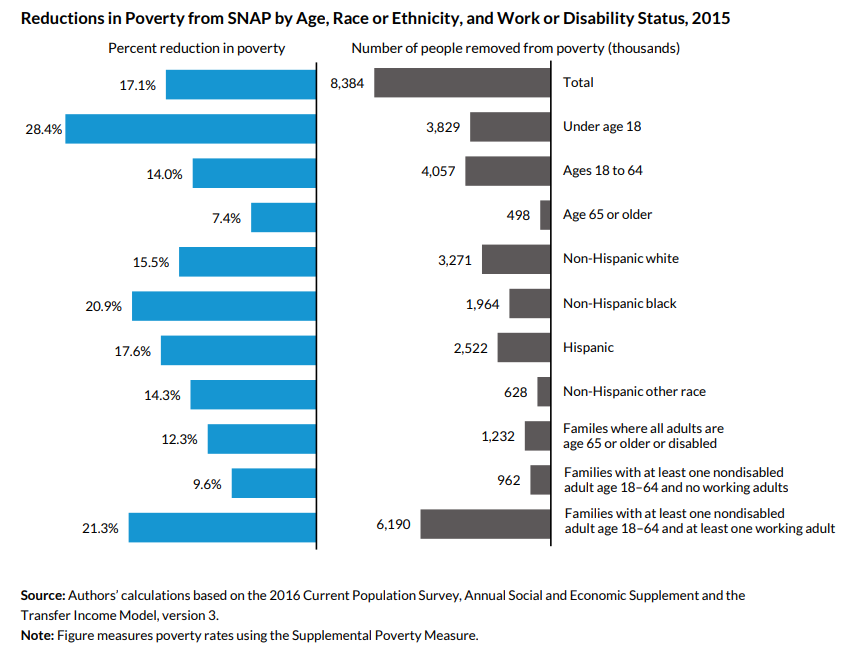
<p>Tyrel Davidson, 18, walks down E. Main Street after applying for food stamps on Monday February 01, 2016 in Ottumwa, IA. Photo by Matt McClain/The Washington Post via Getty Images.</p>
Policymakers are considering major changes to the Supplemental Nutrition Assistance Program (SNAP), which provides food assistance to more than one in eight Americans. The administration’s fiscal year 2019 budget proposal calls for a 27 percent reduction in SNAP spending over 10 years and suggests a new approach that replaces a portion of the SNAP benefit with a US Department of Agriculture “foods package” for certain households. Congress and the administration are considering other program changes as part of the 2018 Farm Bill reauthorization.
As the debate around SNAP intensifies, it is crucial to understand the program’s effects. In addition to helping low-income Americans purchase food and reducing food insecurity, our recent analysis finds that SNAP removed 8.4 million people from poverty in 2015, reducing the poverty rate from 15.4 percent to 12.8 percent.
But what does it mean to remove people from poverty?
To estimate SNAP’s antipoverty effects, we use the Census Bureau’s Supplemental Poverty Measure (SPM), but we enhance the underlying survey data to more fully capture the effects of SNAP and other benefits.
We first determine whether a family’s total resources (income and benefits minus taxes and necessary expenses) are greater than or equal to the federal poverty line as defined by the SPM. We then subtract SNAP benefits from the family’s resources and recalculate their status. If a family’s resources are above the SPM poverty line before subtracting SNAP but are below the poverty line when SNAP is excluded, that family is counted as being removed from poverty by SNAP.
In other words, if that family didn’t have SNAP benefits, they would be below the SPM poverty line. By receiving SNAP, some of the family’s resources are freed up for other necessities, such as clothing, housing, and medical expenses.
Why we correct for underreporting
SNAP’s antipoverty effects are often understated because of underreporting in the survey data used to develop estimates. Underreporting happens when surveyed households don’t report their receipt of SNAP and other means-tested benefits.
SNAP is substantially underreported in the Current Population Survey, Annual Social and Economic Supplement (CPS-ASEC), which provides the data for the Census Bureau’s official poverty estimates and SPM. According to the CPS-ASEC, households received $36.6 billion in SNAP benefits in 2015. But Food and Nutrition Service administrative data show that $68.9 billion in benefits were paid that year. That means the CPS-ASEC captured just over half of total SNAP benefits paid in 2015.
Our analysis corrects for underreporting of SNAP and other government benefits in the CPS-ASEC using a sophisticated microsimulation model that assigns benefits to a subset of eligible households that do not report receiving benefits. Households are selected so that the overall size and composition of the SNAP recipient caseload matches the caseload according to administrative data.
We find that SNAP substantially reduces poverty across demographic groups. Groups with the largest proportionate decline in poverty from SNAP include children (28 percent), people in nonmetropolitan areas (24 percent), people in working families (21 percent), and non-Hispanic black people (21 percent).

Our findings show that in addition to supplementing food purchases for more than one in eight Americans, SNAP has an important antipoverty effect. As policymakers consider changes to social safety net programs like SNAP, it is important to understand their full impact.
Let’s build a future where everyone, everywhere has the opportunity and power to thrive
Urban is more determined than ever to partner with changemakers to unlock opportunities that give people across the country a fair shot at reaching their fullest potential. Invest in Urban to power this type of work.